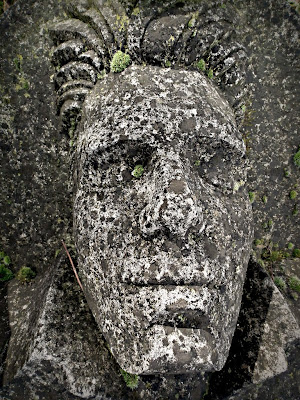 |
| Sterne's original headstones photographed in St George's Field around 1905 |
“He had boasted
in "Tristram Shandy" that his preference would be to die in an inn,
untroubled by the presence and services of his friends; yet when, in his London
lodgings, he began to realize that death might be near, he pined for his
daughter Lydia to nurse him. Only a hired nurse and a footman stood by Sterne's
deathbed. The latter had been sent to inquire after the health of the famous
author, and, being told by the landlady of the house to go upstairs and see for
himself, he reached the death-chamber just as Sterne was passing away. Putting
up his hand as though to ward off a blow, he ejaculated, "Now it is
come," and so died. The story goes that even as he was dying, the nurse was
busy possessing herself of the gold sleeve-links from his wrists.”
Henry C. Shelley “Untrodden English Ways.”
The
author of “The Life & Opinions of Tristram Shandy, Gentleman” was never
really a Londoner. He was born in Ireland and raised there and in Yorkshire where
he spent most of his adult life. His careers as clergymen and professional
author afforded him plenty of opportunity to travel and he visited London often
but he was never really part of the capitals Augustan literary scene which may
have partly accounted for Dr Johnson’s rather dismissive attitude towards him (What do you think of ‘Mr Sterne Dr Johnson? “Licentious and
dissolute in conversation Sir.” But a great author don’t you think? “Nothing
odd will do long, ‘Tristram Shandy’ did not last.”). Sterne was in London overseeing
the publication of his second novel “A Sentimental Journey” when a dose of flu
proved too much for a constitution undermined by years of suffering with
consumption and he died at his lodgings at 41 Old Bond Street on the 18th
March 1768. He was 54 years old.
Sterne
was buried at St George Hanover Square’s new burial ground just off the
Bayswater Road. According to one early edition of his work he was buried with
“no bell tolling”, accompanied by just a pair of mourners in a hurried ceremony
in what was generally considered to be a paupers burial ground. One of the
reasons for making little fuss when interring corpses at St George’s Field was
that being relatively out of the way made it popular with body snatchers.
Shortly after Sterne’s funeral the rumours started. Sterne’s body had been
taken from the grave two days after the burial and sold to a University anatomist
for dissection. Some said it was to Dr John Parsons at Oxford, others claimed it
was Dr Charles Collignon at Cambridge. Whether it was Oxford or Cambridge all
accounts say that the body was already being dissected when someone recognised
the corpse as being the deceased author; in some versions it was a student, in
others a friend of the anatomist who dropped in to pay him a visit, in others a
member of the public who was paying to see a public dissection. Edmond Malone
the Shakespearian scholar gossiped with a correspondent “a gentleman who was present
at the dissection told me he recognised Sterne’s face the moment he saw the
body…” Sterne’s corpse was discretely returned to St George’s Field sans head
according to some who reckoned that Dr Parsons or Dr Collignon hung onto the
skull as a souvenir. When the Mason’s paid for a headstone to be set up over
Sterne’s grave some years later no one was sure where exactly his body was
buried. And so the inscription stated “Near to this place lies the body of….” and
the headstone was set up close to the wall in what seemed a likely spot.
In
the late 1960’s when the church authorities decided to sell of St George’s
Field for redevelopment the Laurence Sterne Trust asked for permission to
remove the headstones and remove them to Coxwold in North Yorkshire. They also
asked, and were given, permission to search for Sterne’s remains. Several
skulls were excavated in the vicinity of the headstones one of which, very
unusually, had had the top of the cranium carefully sawn off apparently in a
dissection. Dissected bodies are very unlikely to end up back in a burial
ground as they would simply be disposed of as rubbish once the anatomist had finished
with them. Could the stories of Sterne’s
body being snatched actually be true? The dissected skull and bones associated with
it were exhumed and reburied in Coxwold churchyard.
Sir Joshua Reynolds portrait of the author as a young clergyman





